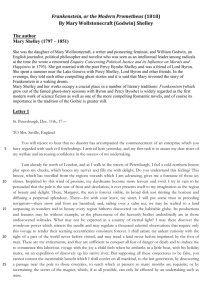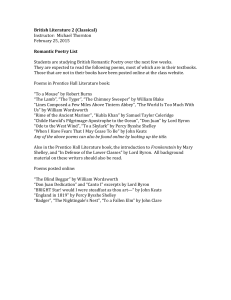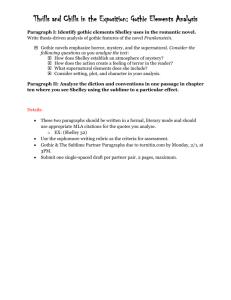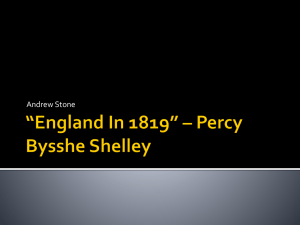the analysis of love and influence in machado de
advertisement
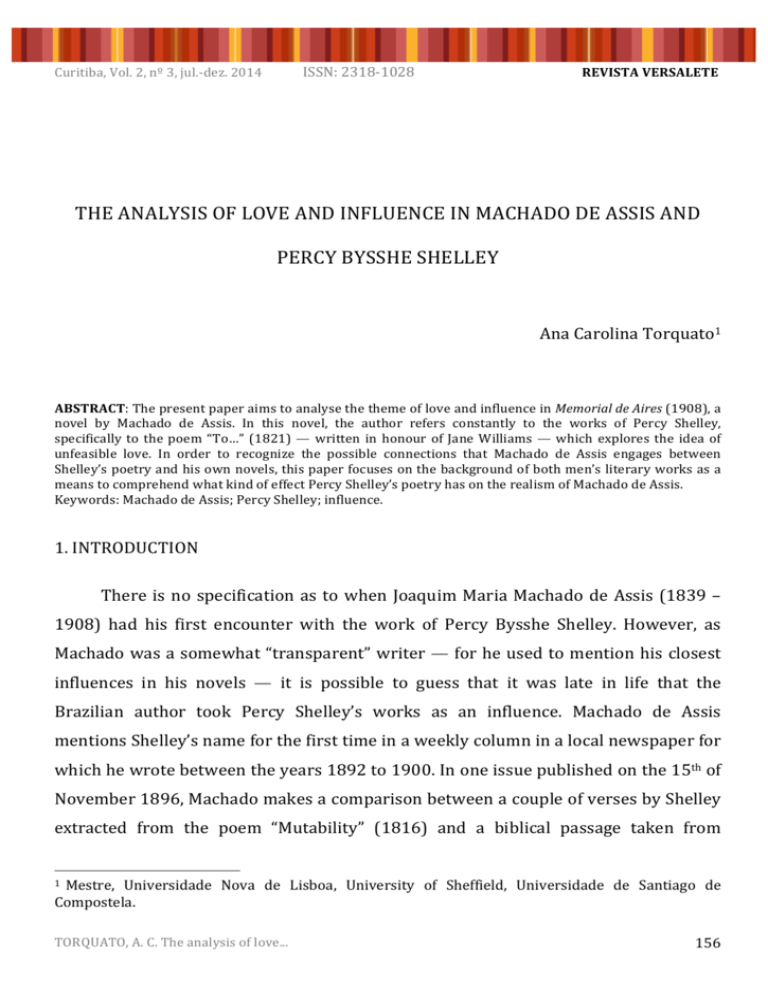
Curitiba, Vol. 2, nº 3, jul.-­‐dez. 2014 ISSN: 2318-­‐1028 REVISTA VERSALETE THE ANALYSIS OF LOVE AND INFLUENCE IN MACHADO DE ASSIS AND PERCY BYSSHE SHELLEY Ana Carolina Torquato1 ABSTRACT: The present paper aims to analyse the theme of love and influence in Memorial de Aires (1908), a novel by Machado de Assis. In this novel, the author refers constantly to the works of Percy Shelley, specifically to the poem “To…” (1821) — written in honour of Jane Williams — which explores the idea of unfeasible love. In order to recognize the possible connections that Machado de Assis engages between Shelley’s poetry and his own novels, this paper focuses on the background of both men’s literary works as a means to comprehend what kind of effect Percy Shelley’s poetry has on the realism of Machado de Assis. Keywords: Machado de Assis; Percy Shelley; influence. 1. INTRODUCTION There is no specification as to when Joaquim Maria Machado de Assis (1839 – 1908) had his first encounter with the work of Percy Bysshe Shelley. However, as Machado was a somewhat “transparent” writer — for he used to mention his closest influences in his novels — it is possible to guess that it was late in life that the Brazilian author took Percy Shelley’s works as an influence. Machado de Assis mentions Shelley’s name for the first time in a weekly column in a local newspaper for which he wrote between the years 1892 to 1900. In one issue published on the 15th of November 1896, Machado makes a comparison between a couple of verses by Shelley extracted from the poem “Mutability” (1816) and a biblical passage taken from 1 Mestre, Universidade Nova de Lisboa, University of Sheffield, Universidade de Santiago de Compostela. TORQUATO, A. C. The analysis of love... 156 Curitiba, Vol. 2, nº 3, jul.-­‐dez. 2014 ISSN: 2318-­‐1028 REVISTA VERSALETE Ecclesiastes (FARIA, G. 2004)2 to elaborate on the inconsistency of life and time. To illustrate the philosophical thought he intended to introduce in one of the weekly chronicles, the author chooses two verses that are quoted in English as an epigraph for his text: “Man’s yesterday may ne'er be like his morrow; Nought may endure but Mutability”. And despite Machado de Assis saying that Shelley revealed only part of the truth of life with these verses, he places these verses in a centralized position in the text and leaves them in their original state, untranslated. The emphasis given to Shelley’s verses seems to acknowledge them as a preamble for what comes next in the text, almost like a misplaced epigraph. This idea is confirmed in the second paragraph when Machado de Assis employs the concept of mutability using a well-­‐known Brazilian landscape to illustrate the imagery expressed by Shelley and Ecclesiastes: “The presence of Corcovado3 sufficed to collate the firmness of the Earth and the mobility of men”4. This example is just one instance of some of the most refined allusions to influential works that would appear in Machado’s fiction; it is an exercise of transferring one text to another and adding a universal character to it that distinguished his literary works from what had been done in Brazil before. He is the first prominent Brazilian writer to transcend a nationalist trend, heading towards creating a genre of his own and being well recognized for it. His most important tool to create such an impressive fictional tradition is influence and this he seems to employ continually throughout his career and most remarkably in the mature works — those texts written between the years of 1880 -­‐ 1908 which started with the publication of 2 FARIA, G. The impossibility of love in Percy Shelley and Machado de Assis. 2004. 3 The Corcovado is a mountain in the middle of Rio de Janeiro city and it holds at its summit the famous statue of Jesus sculpted in stone, the Cristo Redentor. 4 In the original: “Bastava a presença do Corcovado para cotejar a firmeza da Terra com a mobilidade dos homens”. The translation to English is my own. TORQUATO, A. C. The analysis of love... 157 Curitiba, Vol. 2, nº 3, jul.-­‐dez. 2014 ISSN: 2318-­‐1028 REVISTA VERSALETE the novel Memórias Póstumas de Brás Cubas in 18815. In Memórias Póstumas de Brás Cubas he captures the public’s attention by employing a Shandean narrative, mixing life and death, and sadness and happiness while the main character tells his story after his own death. To make his influential inclinations clear for the public, in a paragraph that precedes the first chapter entitled “To the Reader” he, Brás Cubas — the deceased main character —, states that he adopts “Sterne’s free style” (1962, vol. I, p. 510) in the novel that follows. For this essay, I would like to concentrate on Machado de Assis’ last novel, Memorial de Aires (1908)6. This was published in the year of his death and recognized to be one of Machado de Assis’ best and most impressive novels; due to the complexity of the narrative as noted by the in-­‐depth analysis Gledson (1986) gives of the text — in which he points out possible ways to perceive Machado’s irony in an apparently romantic plot. There is also a hidden autobiographical vein to the novel that may contribute to the way readers observe Machado de Assis’ work, and is remarked by Mirella Márcia Longo (2008) as a possible reason why the author chooses to write a novel in the form of a diary (p. 339)7. Memorial de Aires 8 is the story of Counsellor Aires, an old retired diplomat, who returns to Brazil after being on duty in Europe for the better part of his life only to find his existence is lonely. His late wife is buried in 5 Both Eugênio Gomes and John Gledson observe this character in Machado de Assis’ works. In a study entitled Machado de Assis – Influências Inglesas (1976), Gomes draws attention to the influence of humour in Machado’s work: “a obra mais característica de Machado de Assis seja precisamente aquela em que transparece a influência exercida sobre ele por alguns humoristas anglo-­‐saxônicos” (p. 9). Gledson, in the book Machado de Assis – ficção e história (1986), focuses on how the Brazilian author experiments with his literary influences: “juntamente com o reconhecimento do realismo de Machado (...) existe uma tendência muito mais acentuada para admirá-­‐lo como um experimentador da forma narrativa: a herança de Sterne, o precursor da ficção do século XX” (p. 15). 6 See the English version of this text on the following website. This reference is to the text in Portuguese, the translation is my own. <http://books.google.co.uk/books?id=UqFWFZfiCW4C&printsec=frontcover&source=gbs_ge_summa ry_r&cad= 0#v=onepage&q&f=false> 7 LONGO, M. M. Um último romance. In: FANTINI, M (org.). Crônicas da Antiga Corte. Belo Horizonte: Editora UFMG, 2008. 8 See the English translation for this novel: CALDWELL, Helen. Counsellor Ayres’ Memorial, California: University of California Press, 1972. TORQUATO, A. C. The analysis of love... 158 Curitiba, Vol. 2, nº 3, jul.-­‐dez. 2014 ISSN: 2318-­‐1028 REVISTA VERSALETE Austria, his friends are mostly dead and the only emotional attachment that remains in Rio de Janeiro is his sister Rita, who in the end introduces him to a whole new social group that becomes the centre of the narrative. The group is composed of the Aguiar couple, their godson Tristão and Fidélia Noronha, a young widow. Counsellor Aires becomes acquainted with these people after he sees young and beautiful Fidélia in the cemetery visiting her late husband. Amazed by her beauty and by the devoted way she takes care of her husband’s grave, he asks his sister Rita about her. His sister tells him her story and emphasizes how attached she was to her deceased husband. Then, Counsellor Aires even jokes about the widow getting married again but Rita observes that a woman like Fidélia would not remarry. In response to her claim, Aires states that “She’ll marry. In order to marry, it is enough for one to be a widow.” (1972, p. 12). When Rita disagrees, this discussion led her to challenge her brother into marrying the Noronha widow. Counsellor Aires claims that he could not accept the challenge, and seems self-­‐conscious of his age — “With my sixty-­‐two years?” (1972, p. 13). This event, as far as Rita is concerned, is not taken seriously by Counsellor Aires, but as the novel concerns his private memories, structured like a journal, with the reader having access to information undisclosed to the other characters, we know that the idea of marrying Fidélia stays in the back of his mind. The narrative is surrounded by her name, her actions and most of all, her beauty. This is where Shelley comes in, as a way to explain Aires’ thoughts, reminding him of what prevented him from marrying the widow. To illustrate his thoughts on the subject of the “impossibility of love” (FARIA, 2004), the Counsellor quotes a verse taken from Shelley’s poem “To…”9(1821): “I can give not what men call love”. Shelley’s verse serves as a leitmotif in Counsellor Aires’ journal as if to remind him that he cannot have Fidélia. While reading the narrative and understanding his social situation in nineteenth-­‐century Brazil, the reader can comprehend the reasons why Counsellor Aires states that he 9 The first line of this poem is “One word is too often profaned”(Shelley, 2003, p. 590). TORQUATO, A. C. The analysis of love... 159 Curitiba, Vol. 2, nº 3, jul.-­‐dez. 2014 ISSN: 2318-­‐1028 REVISTA VERSALETE will not marry the widow. The age difference does not seem to be problem for the society but it is for Counsellor Aires; and asides from that, Fidélia carries an aura of inaccessibility given by widowhood and the devotion she keeps to her late husband. 2. ABOUT PERCY BYSSHE SHELLEY AND HIS POEM Shelley’s poem quoted in Machado de Assis’ narrative is implicitly dedicated to Jane Williams — who was the centre of Shelley’s attention while he and Mary Shelley lived in Pisa and Lerici, Italy. Jane Williams attracted Percy Shelley’s consideration because of her beauty, musical talents and housewife skills; “according to Mary, Jane ‘has a very pretty voice, and taste and ear for music which is almost miraculous” (WU, 2012, p. 1080). This admiration led him to compose a series of eleven poems to Jane, directed both to her and her husband Edward Ellerker Williams who was also his friend. Since he could not openly disclose his inclination to Jane Williams, Shelley had to find means to incite her curiosity and awareness of his devotion. Throughout all the time of their acquaintance, Percy Shelley never quite acknowledged what his true feelings for Jane were; both of them seem to “struggle to define what it is that they do feel” (O’NEILL & REIMAN, 1997, p. 352) for each other. As for the poems written to her, they share a sense of concealed ambience that was created by him in order not to disclose an actual romantic love for Jane, apart from an admiration for her beauty and talents as a musician. In terms of literary criticism, the sense of suppresion present in this group of poems adds– indefiniteness to their interpretation, since for the ones who read them it is impossible to say for sure what kind of relationship Percy Shelley and Jane Williams had. These poems show Shelley’s uncertainty of the female figures in his life, as pointed out by Paul Vatalaro (1999): “This biographical dynamic, […] is symptomatic of a much more forceful emotional dynamic that involves Shelley's TORQUATO, A. C. The analysis of love... 160 Curitiba, Vol. 2, nº 3, jul.-­‐dez. 2014 ISSN: 2318-­‐1028 REVISTA VERSALETE ambivalence toward the feminine-­‐maternal” (p. 69). The biographical context behind the poem, then, indicates Shelley’s preference for feminine and maternal figures. There is certainly an impossibility that connects Shelley and Jane; maybe the same sort of impossibility that prevents Counsellor Aires from declaring publicly how impressed he was by young Fidélia, although he shows it in subtle ways that may not be clear to everyone. The circumstances that make his “love” for the widow impossible are different than how Shelley describes his admiration for Jane. The way both men express their thoughts and metaphysical considerations on the subject is similar, however, this could be a reason why Machado de Assis chooses Shelley’s verse to depict a similar situation. In fact, adding Shelley’s poetry as a moto to a novel that seems not to be as exciting as Machado’s previous works (GLEDSON, 1986)10, draws the readers attention to the irony that Aires’ words contain. The Counsellor is constantly observing Fidélia’s beauty, suggesting that his remarks towards her are less innocent than he wants the reader to perceive. Gledson (1986) suggests that Aires is not a reliable narrator due to his ceticism and incapability to know his own feelings (p. 225). To return to Shelley’s poem, it is essential for this analysis to understand the poem’s connection to the Brazilian novel, so here it is transcribed: To… One word is too often profaned For me to profane it, One feeling too falsely disdain'd For thee to disdain it. One hope is too like despair For prudence to smother, And pity from thee more dear Than that from another. 10 Gledson (1986) speaks about Memorial de Aires as: “difícil fingir que seja tão emocionante como (…) Brás Cubas, Quincas Borba e Dom Casmurro” (p. 216). TORQUATO, A. C. The analysis of love... 161 Curitiba, Vol. 2, nº 3, jul.-­‐dez. 2014 ISSN: 2318-­‐1028 REVISTA VERSALETE I can give not what men call love; But wilt thou accept not The worship the heart lifts above And the Heavens reject not: The desire of the moth for the star, Of the night for the morrow, The devotion to something afar From the sphere of our sorrow? In this poem, Percy Shelley refuses to call his feelings love due to the pragmatics this word has acquired throughout time, as if it were unstable and often misused by some. His feelings for Jane, as Shelley suggests, are beyond love, perhaps even divine —“And the Heavens reject not” —, something that can be recognized by the heavens and thus take on a godlike character which is not suitable for such a “profane” environment like the Earth. The poem reveals Shelley’s awareness of the impossibility of his relationship with Jane, an unfeasibility which is echoed in the verse “I can give not what men call love” and by the imagery that follows, for example, “The desire of the moth for the star/ (…) The devotion to something afar”. These images illustrate the desire for impossible things, which could be interpreted as an analogy of his feelings for her which are meant to be kept in a utopian sphere. In Paul Vatalaro’s study, The Semiotic Echoes in Percy Shelley's Poems to Jane Williams (1999), he affirms that Shelley sees in Jane a motherly figure by stating that the poet “believes Jane initiates a scenario reminiscent of the early relationship which occurs between a mother and her infant”(p. 72), and that her music sweeps him away to “an other-­‐worldly paradise characterized by unity and intimacy” (p. 72). Although in this specific poem Percy Shelley does not mention Jane Williams’ musical talents, it is known that the poem “To…” is part of a series of poems written in Jane’s honor that emphasize her talents as an inspiration for the author. Among these TORQUATO, A. C. The analysis of love... 162 Curitiba, Vol. 2, nº 3, jul.-­‐dez. 2014 ISSN: 2318-­‐1028 REVISTA VERSALETE are "To Jane. 'The keen stars were twinkling'" "To Jane. The Invitation" "To Jane. The Recollection" and "With a Guitar. To Jane." No wonder Machado de Assis chose this poem specifically to illustrate the concealed adoration Counsellor Aires nurtured for Fidélia Noronha. After all, both Fidélia and Jane Williams share very similar lives and talents; the Noronha widow is also accomplished in the matters of music as it is described by her uncle, “Fidélia sings as well, she has great proficiency and a beautiful voice” (MACHADO DE ASSIS, 1982, p. 91). Further, she is described as an “angel” by the ones who know her: [Dona Carmo asks Counsellor Aires] “Don’t you think she is an angel? I did. I would think more than that, if anyone asked me” (MACHADO DE ASSIS, 1982, p. 54). Both women’s beauty and musical talents are immortalized through the words men who admired them, and each is given an angelic character to their representation. The way Counsellor Aires sees Fidélia seems to be even more innocent, or so he wants the readers to believe. Firstly, everything written about the widow remained undisclosed in Aires’ journal and she never knew of his admiration for her, than the typical sociable courtesies that he paid to her. Second, he would not dare to write her poems or letters of which the content might reveal his feelings. However, some words used by Aires suggest that, although his sexual desire for the widow is hidden, it exists, as it is going to be explored in the next session. In this sense, there is a deep connection between Machado de Assis’ narratives and the reader. The Brazilian author customarily addresses his public in his literary work, but Memorial de Aires’s (1908) case this happens even more often due to the limits between biography and fiction explored in the narrative. Therefore, as the reader has access to the counsellor’s private diary it is possible to understand that he holds Fidélia in high regard but even so, one who tries to interpret the novel can never really affirm that his admiration is more than just a fatherly appraisal. It is all too indefinite. And to depict such situation, Machado de Assis quotes Shelley’s verse in TORQUATO, A. C. The analysis of love... 163 Curitiba, Vol. 2, nº 3, jul.-­‐dez. 2014 ISSN: 2318-­‐1028 REVISTA VERSALETE order to leave his reader in doubt of Counsellor Aires’ intentions, and succeeds; “I cannot give what men call love... and it’s a pity”. 3. THE THEME OF LOVE IN SHELLEY AND MACHADO DE ASSIS There is disagreement among Shelley’s critics on whether the poems written to Jane Williams were mostly platonic or filled with sexual desire and frustration. Critics like Vatalaro (1999) identify in this series of poems an adoration for the motherly figure and the intimacy Jane evokes; whilst critics such as Nathaniel Brown (1979) note that Shelley’s poetry “is meant to be sexually liberating” (p. 50). I believe the poems devoted to Jane Williams present both themes of love and sex; these may vary from one poem to another, but the character of each poem is not fixed and may oscillate from one motive to another very easily. In order to understand the nature of love in these selected poems, it is worth considering some definitions of love given by Shelley in A Defence of Poetry (1821), which was written in the period he was first acquainted with Jane. In the first one, he describes love as a means to virtue, through the contemplation of beauty in something other than the self — "The great secret of morals is Love; or a going out of our nature, and an identification of ourselves with the beautiful which exists in thought, action, or person, not our own." (SHELLEY, 2009, p. 682). Shelley uses this concept in association with the idea of producing art, poetry specifically, viewing this process as cathartic and purifying to him. Accordingly, Shelley makes a comparison between Dante and Petrarch about who has the better understanding of love: “Dante understood the secret things of love even more than Petrarch. His “Vita Nuova” is an inexhaustible fountain of purity of sentiment and language: it is the idealized history of that period, and those intervals of his life which were dedicated to love. His apotheosis of Beatrice in Paradise, and the gradations of his own love and her loveliness, by which as by steps he feigns himself to have TORQUATO, A. C. The analysis of love... 164 Curitiba, Vol. 2, nº 3, jul.-­‐dez. 2014 ISSN: 2318-­‐1028 REVISTA VERSALETE ascended to the throne of the Supreme Cause, is the most glorious imagination of modern poetry” (SHELLEY, 2009, p. 690). To Shelley, Dante presents the most impressive definition of love because his verses are pure and truthfully beautiful, but beauty in Dante is associated with virtue. In the Divine Comedy (1321) he plays with the concept of Heaven and Hell while transferring the concepts of good and bad to his verses. I believe that when Shelley uses the example of Dante in association with love and poetry it is not envisaging the hidden religious content of Dantesque poetry, but the way Dante used language in order to reflect the true purity of sentiment which is also represented by the balance between love and desire. If when Shelley wrote the poems to Jane Williams he was thinking of the concept of love presented in Dante’s work, he might have tried to explore this purity of sentiment in this series of poems expressing his feelings through the means of poetics. The difference between Shelley and Dante is that the former is indecisive about what he wants to show and to conceal in his poetry. This why it may reveal a pure and godlike adoration for Jane Williams while simultaneously associating the idea of carnal desire with her. “The serpent is shut out of from Paradise/ The wounded deer must seek the herb no more” (SHELLEY, 2009, p. 591). The meaning in these lines is clear, revealing a rational mind trying to avoid instigating the impossible. Thus, in the series of poems to Jane, Shelley presents both types of love: the pure and the carnal. The indecision present in these poems is due to the fact that probably the carnal love cannot be consummated either because moral/social values prevent him from doing so or because Jane Williams does not return the feelings. In the poem “To… ”, Shelley affirms that he is not going to taint his feelings for Jane by using the word love — I can give not what men call love—, because it is reularly used in vain, as means to define certain feelings or a state of mind that might be easily mistaken by love. TORQUATO, A. C. The analysis of love... 165 Curitiba, Vol. 2, nº 3, jul.-­‐dez. 2014 ISSN: 2318-­‐1028 REVISTA VERSALETE In Counsellor Aires’ case, the impediments are similar to Shelley’s. Though, Fidélia is a widow as well as he is, there are also two possible reasons that prevent him from going after the young lady. The first is his own morality which prevents him from courting a woman who is much younger than him. The second is the improbability of Fidélia taking interest since she sees him as a friend — a position Counsellor Aires has put himself in. Nevertheless, these impediments do not prevent him from seeing beauty in Fidélia and voicing his concealed desire in his private journal. So, the use of Percy Shelley’s verse as a leitmotif to the impossibility of love is explained by the fact that Machado de Assis recognized the meanings of this poem as the synthesis of Counsellor Aires’ situation. The first time the leitmotif appears in the book is just after Counsellor Aires is formally introduced to Fidélia and contemplates her beauty for the first time. This is the only moment in the narrative that Aires praises her physical beauty with such enthusiasm. “Ao vê-­‐la agora, não a achei menos saborosa que no cemitério, e há tempos em casa de mana Rita, nem menos vistosa também. Parece feita ao torno, sem que este vocábulo dê nenhuma idéia de rigidez; ao contrário, é flexível. Quero aludir somente à correção das linhas — falo das linhas vistas; as restantes adivinham-­‐se e juram-­‐se. Tem a pele macia e clara, com uns tons rubros nas faces, que lhe não ficam mal à viuvez. Foi o que vi logo à chegada, e mais os olhos e os cabelos pretos; o resto veio vindo pela noite adiante, até que ela se foi embora. Não era preciso mais para completar uma figura interessante no gesto e na conversação. Eu, depois de alguns instantes de exame, eis o que pensei da pessoa. Não pensei logo em prosa, mas em verso, e um verso justamente de Shelley, que relera dias antes, em casa, como lá ficou dito atrás, e tirado de uma das suas estâncias de 1821: I can give not what men call love. Assim disse comigo em inglês, mas logo depois repeti em prosa nossa a confissão do poeta, com um fecho da minha composição: ‘Eu não posso dar o que os homens chamam amor... e é pena!’”11 (MACHADO DE ASSIS, 1908, p. 7).12 11 As I looked at her, I found her no less tempting than on that day on the cemetery, or that time before at Mana Rita’s, and no less strikingly beautiful either. She seems to have been shaped on a lathe – without this expression giving any idea of rigidity. On the contrary, she is pliant and soft. I allude only to the correctness of her body’s lines, that is, the ones seen; the others are guessed at, and sworn to. Her skin is smooth and clear, and her cheeks have a ruddy glow that is not unbecoming to her widowhood. (…) After the first few seconds of inspection, there is what I thought of her person. I TORQUATO, A. C. The analysis of love... 166 Curitiba, Vol. 2, nº 3, jul.-­‐dez. 2014 ISSN: 2318-­‐1028 REVISTA VERSALETE In this excerpt, Counsellor Aires’ choice of vocabulary depicts the carnal love he feels, for instance, the word in Portuguese “saborosa”, which in the English version was translated as “tempting”, is employed to describe the Noronha widow. Furthermore, the idea of someone being so beautiful that they seem to have been “feita ao torno”, or in English “shaped on a lathe” implies the proximity to a work of art, which may allude to the purity of his love, as well as an inspiration to sexual desire, like a carved Greek statue. This is the only part in the whole novel where Aires hints at his devotion to the beautiful and desirable Fidélia. From the very start he explains that even if he notices her striking beauty, he cannot do anything about it. By giving his own version of Shelley’s verse, Aires revises the original meaning to add his own perception on the situation in which he employs the verse. By interacting with influence in the narrative, Machado de Assis is engaging in an act of revision similar to Harold Bloom’s theory in The Anxiety of Influence (1997) in what he called Tessera, meaning the process when “a poet antithetically ‘completes’ his precursor, by so reading the parent-­‐poem as to retain its terms but to mean them in another sense, as though the precursor had failed to go far enough” (BLOOM, 1997, p. 14). Machado de Assis indeed completes Shelley’s verse and maintains its terms, but this completion seems to be a way to bring the verse closer to the purposes of the novel and does not present an antithetical character. The use of influence, in this case, seems to be Machado’s attempt to interact with audience, giving them the possibility to be a first or second-­‐level model reader (ECO, 2004). As Umberto Eco describes, a first-­‐level reader just pays attention to the plot did not immediately think in prose, but in verse as it happened, in a line of Shelley, whom I have been rereading at home, as I mentioned above, a verse of one of his stanzas from 1821: I can give not what men call love. Just so I quoted to myself in English; but then, right after, I repeated the poet’s confession in our prose and with a close of my own composition: “I cannot give what men call love…and it’s a pity!” (Machado de Assis, 1982, p. 19-­‐20) 12 In this quote, I use the text provided by the website Domínio Público. See the following link <http://www.dominiopublico. gov.br/dowload/texto/bn000025.pdf> TORQUATO, A. C. The analysis of love... 167 Curitiba, Vol. 2, nº 3, jul.-­‐dez. 2014 ISSN: 2318-­‐1028 REVISTA VERSALETE and is unable of perceiving the details of the text; when a second-­‐level reader is capable of realizing the subleties intended by the author, surpassing the surface of the text and interpreting the work in depth. Memorial de Aires needs a second-­‐level reader who is able not to trust the narrator and, finally, understand his style. 4. CONCLUSION The purpose of this essay was to draw connections between the poems written by Percy Bysshe Shelley to Jane Williams and the novel Memorial de Aires (1908) by Machado de Assis. Both literary works, although distant in place seem to be connected in terms of theme and motive. Machado de Assis recognizes in Shelley’s verses a possibility to establish a dialogue and validate the irony that is charachteristic of his works, so these could be the Brazilian writers’ readers to understand the novel in a deeper way and engage in discussion to what kind of hidden plots Memorial de Aires presents. Furthermore, Shelley’s perspective of love seems to be what Machado wishes his narrative to have and that is, I believe, why he uses the poem as to represent his own literary voice in accordance with other influential works. REFERENCES BLOOM, H. Joaquim Maria Machado de Assis. In: Genius: A Mosaic of One Hundred Exemplary Creative Minds. New York: Warner, pp. 673 – 680, 2002. BLOOM, H. The Anxiety of Influence. New York: Oxford University Press, 1997. BROWN, Nathaniel. Sexuality and Feminism in Shelley. Cambridge: Harvard University Press, 1979, p. 50. CASTRO ROCHA, J. C. (ed.). The Author as a Plagiarist: The Case of Machado de Assis. Portuguese and Cultural Studies 13/14. Dartmouth MA: Center for Portuguese Studies and Culture, 2005. TORQUATO, A. C. The analysis of love... 168 Curitiba, Vol. 2, nº 3, jul.-­‐dez. 2014 ISSN: 2318-­‐1028 REVISTA VERSALETE DRABLE, M (ed). The Oxford Companion to English Literature. New York: Oxford University Press, 2009. ECO, Umberto. On Literature. Translation by Martin McLaughlin. Florida: RCS Libri, 2002. FARIA, G. L. The Impossibility of Love in Percy Shelley and Machado de Assis, In: The 17th Congress of International Comparative Literature Association, Hong Kong. Proceedings of the 17th Congress of ICLA, 2004. GLEDSON, J. Machado de Assis: Ficção e História. Trad. Sônia Coutinho. Rio de Janeiro: Paz e Terra, 1986. GOMES, E. Machado de Assis — Influências Inglesas. Rio de Janeiro: Pallas, 1976. MACHADO DE ASSIS, J.M. Machado de Assis: Obra Completa em três volumes. Rio de Janeiro: Editora José de Aguilar Ltda., 1962. MACHADO DE ASSIS, J.M. Counsellor Ayres’ Memorial. Translation by Helen Caldwell. Los Angeles: University of California Press, 1982. MACHADO DE ASSIS, J. M. Memorial de Aires. Disponível em <http://www.dominiopublico.gov.br/download/texto/bn000025.pdf>. O'NEILL, M.; REIMAN, D. H.. Shelley VIII: Fair-­‐Copy Manuscripts of Shelley's Poems in European and American Libraries. Manuscripts of the Younger Romantics. 7. Routledge, 1997. SHELLEY, P. Percy Bysshe Shelley: The Major Works. ed. Zachary Leader and Michael O’Neill. Oxford: Oxford University Press, 2009. VATALARO, P. The Semiotic Echoes in Percy Shelley's Poems to Jane Williams. In: Keats-­‐Shelley Journal,Vol. 48 (1999), p. 69-­‐89. WU, D. (ed.). Romanticism: An Athology. Oxford: Wiley-­‐Blackwell, 2012. Submetido em: 21/03/2014 Aceito em : 21/04/2014 TORQUATO, A. C. The analysis of love... 169
